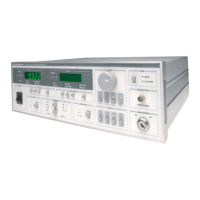REMOTE OPERATION
Advanced Programming
10_15 LDC-3900 Series 61
CHAPTER 3
Advanced Programming
Once you have become familiar with the command syntax and structure, you may
take advantage of some programming shortcuts which are available. Due to the
"tree-walking" capabilities of the LDC-3900 software, the user may elect to write
command strings without constantly repeating the entire command path for each
command.
Path Specification
The first command in the string must have its entire path entered. But once a path
level is reached, other commands which are at the same level (or higher level)
may then be entered without repeating the path. To accomplish this, the
semicolon (;) must be used to separate the commands in the string, as usual.
However, the command following the semicolon need not specify its full path, if
the same path which was previously written out could be used for the new
command.
For example, the following legal command string could be used to (1) set the
LDC-3900 TEC display to the measured temperature and (2) set the TEC display
for the (temperature) set point value:
"TEC:DIS:T;Set"
The path "TEC:DIS:" is "remembered" by the LDC-3900 software in this case. If
the "Set" command were not found at this level, the software would walk back to
the "TEC:" level and search for a "TEC:Set" command. If it is not found there, it
will search at the next higher level, and so on until it finds the command or not. If
the command is not found, an error message will be generated.
The following is an example of command "tree-walking", where (1) the Laser
display is set for the current set point, and (2) the Laser output is turned on:
"Laser:display:set;out on"
The command "out" is first searched at the "LAS:DIS:" level. Since the command
"LAS:DIS:OUT" does not exist, the next higher level "LAS:" is searched. There the
command "LAS:OUT" is found, and the parameter "on" is legal, so there is no
error.
Care must be taken to avoid errors which are caused by trying to implement
commands from the wrong path or level. For example, the following command
string was intended to (1) read back the set point resistance and (2) read back the
measured resistance:
"TEC:Set:R?;R?"
Instead, the output would return the set point resistance twice. When the second
"R?" is found, the software will first search for that command at its current level.

